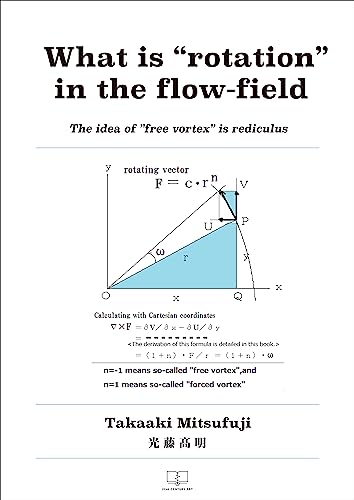
What is “rotation” in the flow-field - The idea of ”free vortex” is ridiculous-
(著) 光藤髙明
Amazon作品詳細
[About the Products]
―ヘルムホルツの呪縛―
回転ベクトル場の回転の速さ;Fが、回転中心からの距離;rだけで与えられる場合、F=c・r^n(^は冪指数)と言う式を用いると、この式だけで一般的な回転ベクトル場の特性を示す事が出来ます。例えば、n=-1で、回転半径に反比例する回転ベクトル場(いわゆる自由渦)を、n=1で回転半径に比例する回転ベクトル場(いわゆる強制渦)を示す事が出来ます。
この回転ベクトル場の特性を示す式を用いて、∇×Fを計算すると、∇×F=(1+n)・F/rに成ります。
現代流体力学では、∇×Fはベクトル場Fのその場の微小部分の回転を示す値であって、全体の公転流れによる回転F/rは、この式に含まれないと言われて居ますが、計算に寄ると100%公転流れの大きさがこの式に表れています。さて、現代流体力学の常識とこの本の主張と、どちらが正しいのでしょう?
If the magnitude of the velocity of the rotating vector field F is determined only by the radius r, and is given by F=c・rn, then ∇×F becomes (1+n)・F/r.
Using this distribution characteristic of F=c・rn, we can show the rotating vector field so-called "forced vortex" with n=1 and the rotating vector field so-called "free vortex" with n=-1.
The meaning of ∇×F=(1+n)・F/r shows that ∇×F is completely related to the value of the so-called revolution, not the rotation of the local part.
[Contents]
Introduction・・・・・・・・・・・・・・・・・・・・1
1.Basic physical quantity to show the flow-field
1.1 Velocity and rotation of fluid particles ・・・・4
1.2 Uniform flow and spatial change in velocity ・13
1.3 Stretch and divergence・・・・・・・・・・・17
1.4 Divergence-free flow and streamline function・21
1.5 ”Shear”and”Total shear” ・・・・・・・・・23
1.6 "Total shear" and velocity potential・・・・・30
2.Combination of∂V /∂x and-∂U /∂y
2.1 The composition of∂V /∂x and−∂U /∂y・・・・33
2.2 Change by increasing−∂U /∂y・・・・・・・・36
2.3 Change by reducing−∂U /∂y・・・・・・・・・39
2.4 About "shear" on the x-axis ・・・・・・・・・43
3.Meaning of∇ ×F
3.1 Fluid particles basically move in a curve・・・・52
3.2 The true mean of the formula∇×F・・・・60
4.About 4 types of rotating velocity fields
4.1 Inversely proportional to radius・・・・・・・64
4.2 Proportional to the radius・・・・・・・・・・78
4.3 Same peed in all places ・・・・・・・・・・・84
4.4 Inversely proportional to the square of r・・・・86
4.5 "Rotation" can’t be determined by a vector 89
5.Navier-Stokes equation
5.1 Euler's equation・・・・・・・・・・・・・・・96
5.2 Navier-Stokes equation・・・・・・・・・・・・98
Conclusion ・・・・・・・・・・・・・・・・・・・・105
[About the author]
1944.6.6. Born in Imabari City, Ehime Prefecture, Japan
1968 : Employed by Japan Weather Association
2001 : Retired from Japan Weather Association
2002 : Published 「日本の猛暑はどこから来るか」:just in Japanese. it means "Where does the heat wave of Japan come from?".
新刊情報
求人情報











